Sambar Rice is a hearty one-pot delicacy from Tamil Nadu that blends the rich flavors of sambar with the comforting nature of rice to create a satisfying and balanced meal. Unlike the traditional sambar served separately with rice, here both are cooked together, letting the flavors mingle and deepen.

While it shares some similarities with Karnataka’s Bisi Bele Bath, Sambar Rice stands out with its distinct Tamil-style spices and texture.
Vegetables – Simple or Seasonal
In this version, we’ve added a few everyday vegetables—onions, tomatoes, carrots, and green beans—but the beauty of Sambar Rice lies in its flexibility. You can easily toss in drumsticks, brinjal (eggplant), capsicum, radish, or any seasonal produce you have on hand. It’s a fantastic way to use up leftover veggies and boost the dish’s nutrition.
The Secret is in the Masala
What sets this recipe apart is the use of a freshly ground masala paste, made with spices and coconut. This aromatic blend adds a rich and authentic flavor that store-bought sambar powders simply can’t match. However, if you’re pressed for time, ready-made sambar powder is a convenient alternative. Just know that freshly prepared masala elevates the dish with layers of complexity and freshness.
Why You’ll Love It
Every spoonful of this Sambar Rice offers the perfect harmony of lentils, vegetables, rice, and spices. It’s hearty, satisfying, and loaded with nutrients. On days when you don’t feel like cooking multiple dishes—dal, rice, sabzi—this one-pot wonder is a savior.
Enjoy it warm, topped with a spoonful of ghee, and serve alongside crispy roasted papad or tangy pickle for a comforting and flavorful South Indian feast.
Ingredients For Sambar Rice:
For Pressure Cooking:
- ½ cup Sona Masoori rice – This short-grain rice variety is light and aromatic, perfect for one-pot meals like Sambar Sadam as it absorbs flavors beautifully and cooks to a soft, fluffy texture.
- ⅓ cup Arhar dal (also known as toor dal or split pigeon peas) – A staple lentil in South Indian cooking, arhar dal adds protein and a slightly nutty taste, forming the creamy base of the dish.
- Salt, to taste – Adjust the salt depending on your preference and the saltiness of the sambar powder or masala used.
- 2 cups Water – Used to cook the rice and dal together until they are soft and well blended, creating a slightly mushy, comforting consistency typical of Sambar Sadam.
For Spice Paste:
- 1 teaspoon Coriander seeds (sabut dhaniya) – These seeds offer a warm, citrusy flavor that forms the backbone of many South Indian spice blends, enhancing the overall depth of the dish.
- 1 teaspoon Cumin seeds – Known for their earthy aroma and slightly bitter taste, cumin seeds add a smoky undertone that balances the tangy and spicy elements of the sambar.
- 6–8 Black peppercorns – These whole peppercorns lend a gentle heat and pungency, contributing to the bold, robust profile of the freshly ground masala.
- 2 Dried red chilies (broken, with stems and most seeds removed) – These chilies add a bright color and smoky spice to the masala; removing the seeds keeps the heat moderate while retaining flavor.
- ¼ teaspoon Fenugreek seeds (methi dana) – Slightly bitter and nutty, these seeds are used sparingly to enhance the sambar’s complexity and support digestion.
- ¼ cup Grated coconut (fresh or frozen) – Coconut lends a creamy, slightly sweet richness to the masala, balancing the spices and making the sambar sadam velvety and flavorful.
- ½ cup Water (for grinding) – Added gradually while grinding the spices and coconut into a smooth paste, this helps achieve the right consistency for even blending into the rice-lentil mixture.
For Cooking Veggies:
- 1 tablespoon Tamarind pulp – Soak in ½ cup hot water to extract its tangy essence, which adds a distinct sourness to the dish.
- 1 tablespoon Ghee (clarified butter) – Used for tempering, it brings a rich, nutty aroma that enhances overall flavor.
- ½ teaspoon Mustard seeds – These seeds splutter in hot ghee, adding a sharp and pungent kick to the tempering.
- ½ teaspoon Cumin seeds – Earthy and aromatic, cumin seeds deepen the flavor base when tempered with mustard.
- 2 Dried red chilies – Broken and added to hot ghee, they bring heat and smokiness to the dish.
- 8–10 Curry leaves – These fragrant leaves are essential in South Indian cooking, infusing the dish with their unique aroma.
- ½ cup Chopped red onion (or shallots) – Onions add sweetness and depth to the base; shallots work equally well for a more traditional touch.
- ½ cup chopped tomatoes – Tomatoes balance the spice and sourness with their mild acidity and natural sweetness.
- ¼ cup chopped carrots – Adds a subtle sweetness and soft texture that complements the overall dish.
- ¼ cup chopped green beans (French beans) – Provide freshness, fiber, and a slight crunch to the dish.
- ½ teaspoon Turmeric powder – Offers a warm color and earthy flavor, while also acting as a natural anti-inflammatory.
- Salt, to taste – Balances the dish; adjust as per preference and other salty ingredients.
- ½ cup + ½ cup Water – Used during different stages of cooking to soften veggies and adjust consistency.
Step-by-Step Instructions to make Sambar Rice:
1) Soak the tamarind – Take the tamarind and place it in ½ cup of hot water. Let it soak for about 15–20 minutes so it softens well. After soaking, mash it using your fingers to release the pulp. Strain this mixture using a fine sieve and discard any seeds or fibrous strands. Set the tamarind extract aside for later use.
2) Prepare rice and dal – In a pressure cooker, add the measured Sona Masoori rice and toor dal.

3) Rinse thoroughly – Wash the rice and dal together by rinsing 2–3 times under running water until the water turns clear. This removes excess starch and impurities.
4) Add water and salt – Pour in 2 cups of fresh water and add a pinch of salt to taste.
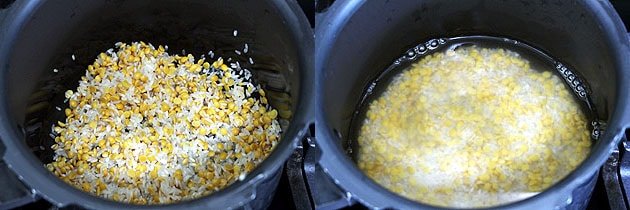
5) Pressure cook – Close the cooker with its lid and place the weight on top. Cook over a medium flame for 2–3 whistles. Once cooking is complete, switch off the heat and allow the pressure to release on its own before opening the lid. Once safe, open the lid.
6) Mash gently – Using a spatula, stir and mash the cooked rice and dal mixture gently to make it smooth and uniform.
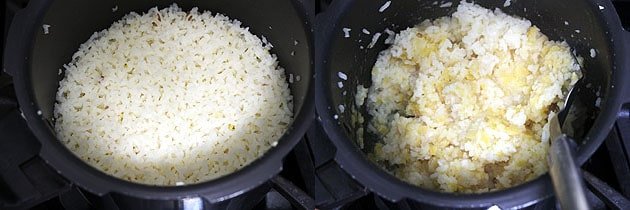
7) Roast whole spices – Meanwhile, in a small pan, dry roast coriander seeds, cumin seeds, peppercorns, dried red chilies, and fenugreek seeds over low to medium heat. Stir constantly for even roasting.
8) Turn off the heat as soon as the spices release a rich aroma, then let them cool down completely before grinding. Transfer them to a plate and allow them to cool completely.
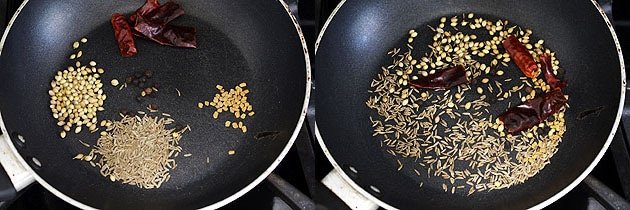
9) Grind to a powder – Add the cooled spices to a grinder jar and blend them into a fine powder.
10) Add coconut and water – Add the grated coconut and half a cup of water into the same grinder jar.
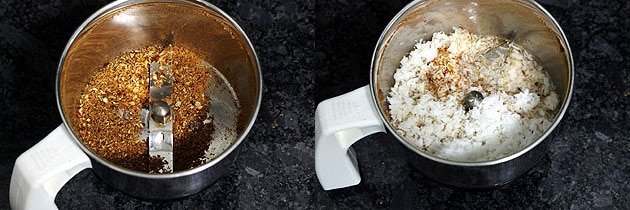
11) Make a smooth paste – Blend everything into a smooth, thick masala paste. Set aside.
12) Heat ghee for tempering – In a wide pan, heat ghee over a medium flame. Once hot, add mustard seeds.
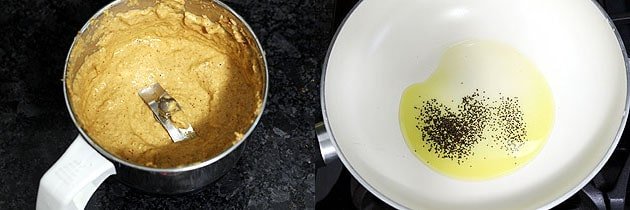
13) Add cumin seeds – Once the mustard seeds begin to pop, add the cumin seeds and sauté them for a few moments.
14) Add red chilies and curry leaves – Add the dried red chilies and fresh curry leaves to the pan.
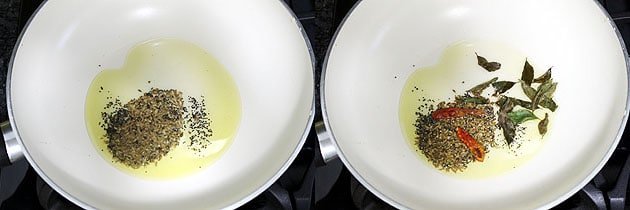
15) Add onions – Now add the chopped red onions (or shallots) and give a quick stir.
16) Sauté till soft – Sauté the onions until they turn soft, translucent, and take on a light pink hue.
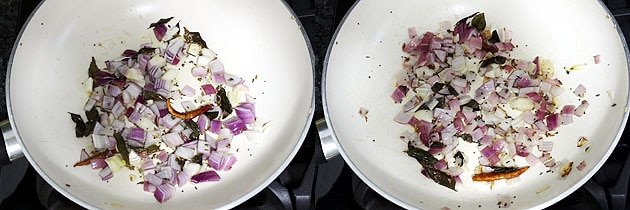
17) Add veggies – Stir in the chopped tomatoes, carrots, and green beans into the pan.
18) Combine well – Mix everything thoroughly to coat the veggies in the tempering.
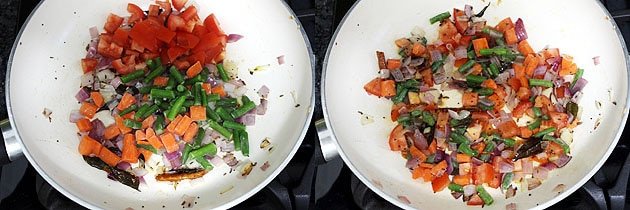
19) Season – Sprinkle turmeric powder and additional salt if needed.
20) Cook briefly – Mix and let the vegetables cook for about a minute to start softening.

21) Add water – Pour in ½ cup of water to aid cooking.
22) Cook covered – Cover the pan with a lid and cook until the vegetables are fork-tender. Add a splash of water if it dries out.

23) Add the spice-coconut paste – Stir in the freshly prepared masala paste.
24) Simmer – Cook this mixture for 2 minutes so the flavors meld.
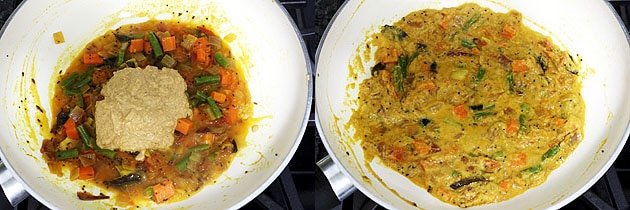
25) Add tamarind extract – Now add the strained tamarind water along with another ½ cup of water.
26) Simmer again – Allow it to simmer for 3–4 minutes to remove any raw tamarind flavor.
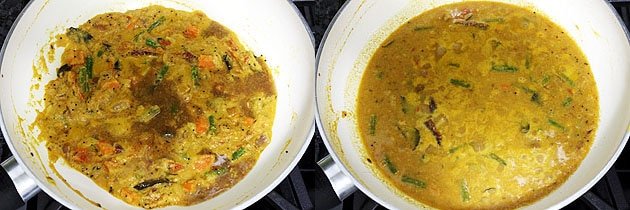
27) Mix dal-rice – Add the mashed dal-rice mixture to the pan.
28) Final mix and adjust – Mix everything well. Simmer for 2 more minutes. If it feels too thick, adjust with warm water to reach your desired consistency. Turn off the heat.
Serve hot or warm Sambar Rice with roasted papad or pickle for a complete and comforting South Indian meal.
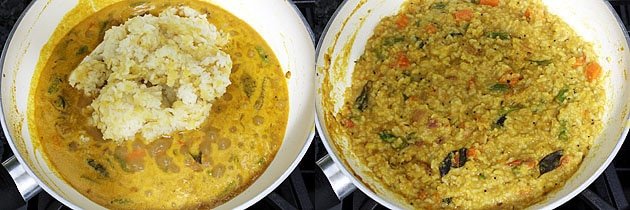
Serving Suggestion for Sambar Rice:
Sambar Rice makes for a hearty and satisfying meal, especially when served alongside crispy papadum and tangy pickle. Its rich flavors and wholesome ingredients come together beautifully, making it enjoyable even when it cools down. This quality makes it an excellent option for packing in lunch boxes, as it retains its taste and texture well throughout the day. Whether eaten fresh or later, sambar rice offers a comforting and nourishing experience that’s perfect for any mealtime.

